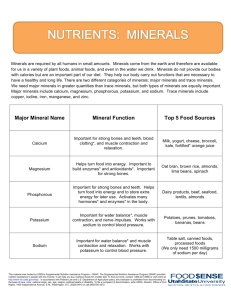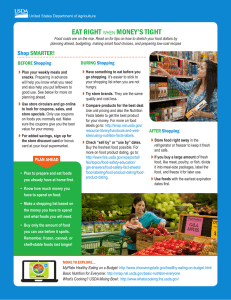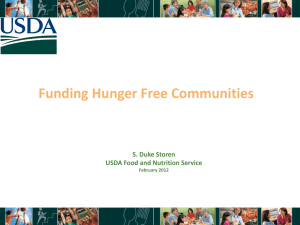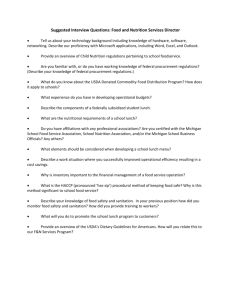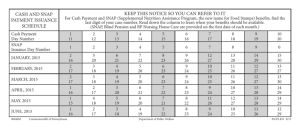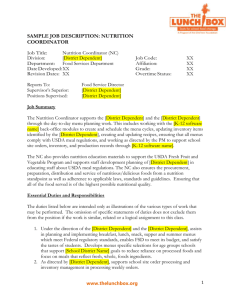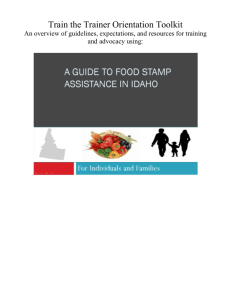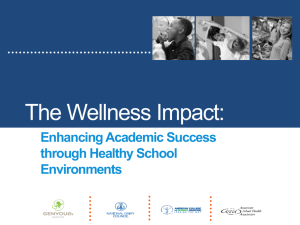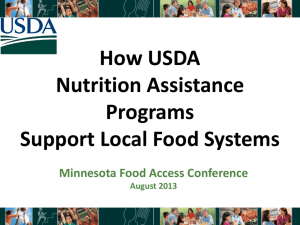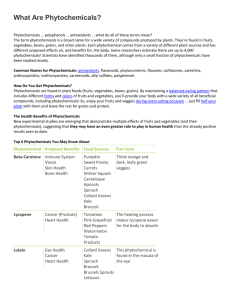Phytochemical Name Phytochemical Function Top 5 Food Sources
advertisement
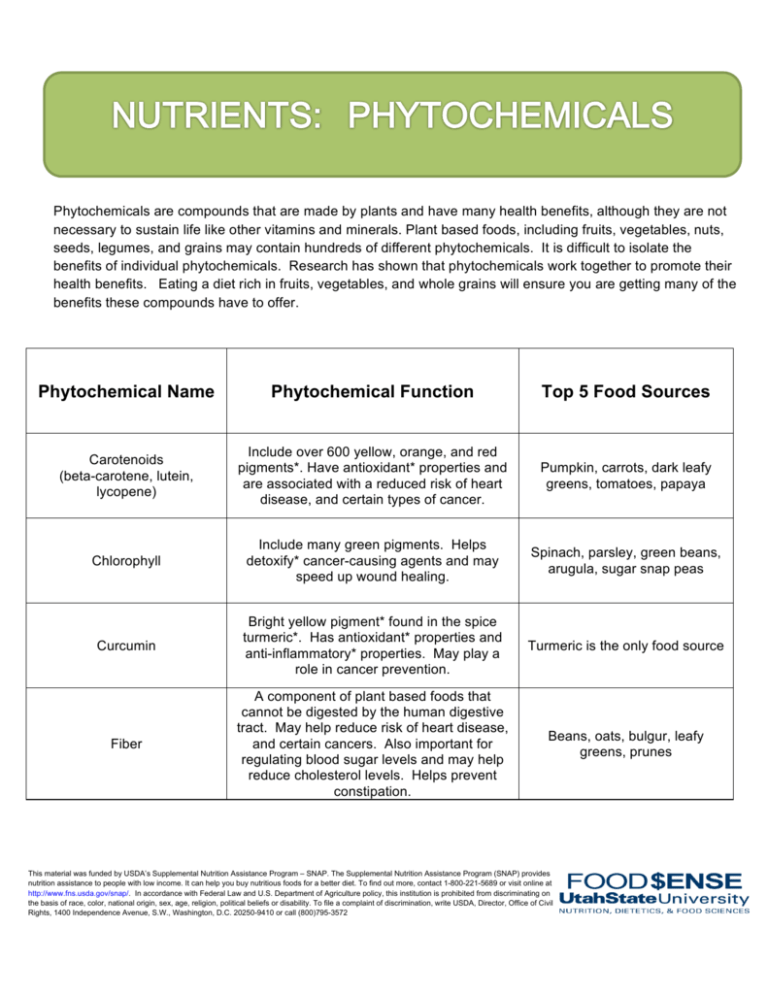
! ! ! ! ! ! Phytochemicals are compounds that are made by plants and have many health benefits, although they are not necessary to sustain life like other vitamins and minerals. Plant based foods, including fruits, vegetables, nuts, ! seeds, legumes, and grains may contain hundreds of different phytochemicals. It is difficult to isolate the ! of individual phytochemicals. Research has shown that phytochemicals work together to promote their benefits health benefits. Eating a diet rich in fruits, vegetables, and whole grains will ensure you are getting many of the ! benefits these compounds have to offer. Phytochemical Name Phytochemical Function Top 5 Food Sources Carotenoids (beta-carotene, lutein, lycopene) Include over 600 yellow, orange, and red pigments*. Have antioxidant* properties and are associated with a reduced risk of heart disease, and certain types of cancer. Pumpkin, carrots, dark leafy greens, tomatoes, papaya Chlorophyll Include many green pigments. Helps detoxify* cancer-causing agents and may speed up wound healing. Spinach, parsley, green beans, arugula, sugar snap peas Curcumin Bright yellow pigment* found in the spice turmeric*. Has antioxidant* properties and anti-inflammatory* properties. May play a role in cancer prevention. Turmeric is the only food source Fiber A component of plant based foods that cannot be digested by the human digestive tract. May help reduce risk of heart disease, and certain cancers. Also important for regulating blood sugar levels and may help reduce cholesterol levels. Helps prevent constipation. Beans, oats, bulgur, leafy greens, prunes ! ! This material was funded by USDA’s Supplemental Nutrition Assistance Program – SNAP. The Supplemental Nutrition Assistance Program (SNAP) provides nutrition assistance to people with low income. It can help you buy nutritious foods for a better diet. To find out more, contact 1-800-221-5689 or visit online at http://www.fns.usda.gov/snap/. In accordance with Federal Law and U.S. Department of Agriculture policy, this institution is prohibited from discriminating on the basis of race, color, national origin, sex, age, religion, political beliefs or disability. To file a complaint of discrimination, write USDA, Director, Office of Civil Rights, 1400 Independence Avenue, S.W., Washington, D.C. 20250-9410 or call (800)795-3572 ! ! ! Phytochemical Name Phytochemical Function Top 5 Food Sources Flavonoids (anthocyanidins, flavanols, flavones) A large family of compounds that includes Have antioxidant* and anti-inflammatory* properties. Helps maintain a healthy heart and urinary tract. Berries, tea, dark chocolate, citrus foods, cranberries Resveratrol May help protect the heart from artery damage. May help protect against some cancers. Grapes, grape juice, peanuts Soy Isoflavones May help reduce LDL cholesterol* levels. May decrease the risk of certain types of cancer. Tofu, miso, soybeans (edamame), tempeh, soy milk ! ! * Word Bank Definition Antioxidant A substance in the body that prevents damage to cells. Anti-inflammatory Helps reduce inflammation in the body. Detoxify To destroy the toxic properties of a substance. LDL cholesterol The “harmful” cholesterol. Turmeric A bright yellow spice often used in Southeast Asian cooking. ! ! This material was funded by USDA’s Supplemental Nutrition Assistance Program – SNAP. The Supplemental Nutrition Assistance Program (SNAP) provides nutrition assistance to people with low income. It can help you buy nutritious foods for a better diet. To find out more, contact 1-800-221-5689 or visit online at http://www.fns.usda.gov/snap/. In accordance with Federal Law and U.S. Department of Agriculture policy, this institution is prohibited from discriminating on the basis of race, color, national origin, sex, age, religion, political beliefs or disability. To file a complaint of discrimination, write USDA, Director, Office of Civil Rights, 1400 Independence Avenue, S.W., Washington, D.C. 20250-9410 or call (800)795-3572 ! ! ! ! This material was funded by USDA’s Supplemental Nutrition Assistance Program – SNAP. The Supplemental Nutrition Assistance Program (SNAP) provides nutrition assistance to people with low income. It can help you buy nutritious foods for a better diet. To find out more, contact 1-800-221-5689 or visit online at http://www.fns.usda.gov/snap/. In accordance with Federal Law and U.S. Department of Agriculture policy, this institution is prohibited from discriminating on the basis of race, color, national origin, sex, age, religion, political beliefs or disability. To file a complaint of discrimination, write USDA, Director, Office of Civil Rights, 1400 Independence Avenue, S.W., Washington, D.C. 20250-9410 or call (800)795-3572 ! !
